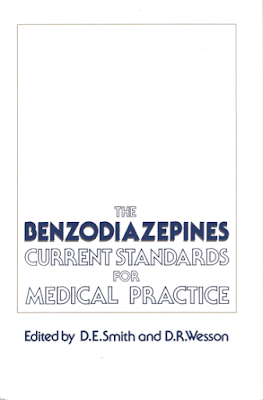The topic of benzodiazepines will just not go away. At the top and bottom of this post - I include a number of book covers from my library on the topic from the last 30 years. The publication dates are 1983, 1985, and 1990. I wrote a brief review for the Psychiatric Times and included my unedited version on this blog from earlier this year. My overall message was that benzodiazepines as a group are great for very specific indications. In fact for some indication like detoxification from alcohol or sedative hypnotic drugs and catatonia they are life saving. The majority of benzodiazepines are not prescribed for those indications. They are prescribed primarily as add on medications for anxiety and insomnia. Their use is limited by tolerance and addictive properties that are expected from a medication that reinforces its own use. It is also problematic to prescribe them to any population of patients where alcohol use is prevalent and not expect significant drug interactions or abuse.
I really wanted to include a graphic from the paper listed below (1) from JAMA Psychiatry on the prescribing rates of benzodiazepines in patients being treated for depression. I will post it if I get permission. That graph illustrates the growth in benzodiazepine prescribing from 2001 to 2104. During that time the fraction of patients taking a benzodiazepine in addition to an antidepressant rose from 6% to 12.5% of the depression treated patients. Subgroups were analyzed and psychiatry came across as a the top prescriber of benzodiazepines across all years. Other practitioners and specialists came in under the curve prescribed by psychiatrists.
A recent anxiety disorder diagnosis was a strong predictor of concurrent use of benzodiazepine use with 24.1% of patients with a recent unspecified anxiety disorder diagnosis and 39.1% or patients with a panic disorder diagnosis taking both the benzodiazepine and antidepressant. At 6 months 45.6% of the antidepressant + benzodiazepine and 48.1% of the antidepressant monotherapy were still taking an antidepressant. After initial adjustments 12.3% of the simultaneous benzodiazepine and antidepressant users received long term benzodiazepines with 5.7% taking them for one year. The prescribed benzodiazepines were almost all high potency including alprazolam (43.9%), lorazepam (26.3%), and clonazepam (21.8%). About a tenth (13.5%) of the patients got a limited supply of for only 1-7 days).
The authors generally conclude that benzodiazepine prescribing seems to be consistent with current guidelines. These suggest that a Cochrane report that concomitant benzodiazepine use with antidepressants increased the short term antidepressant response and decreased the drop out rate attributable to antidepressant side effects. I would think that would be offset at least as much by guidelines suggesting limited use.
The overall strength of this report is that it is a study of a very large insurance database population of 684,100 new antidepressant users and 81,020 simultaneous antidepressant and benzodiazepine users. They give a breakdown of antidepressant classes (overwhelmingly SSRIs). Only 12.7% and 16.5% (respectively) of the patients in each class were treated by psychiatrists. Interestingly 77.4% and 80% of each class had not received any form of psychotherapy, although it is conceivable that at least some patients were being seen by therapists outside of the database. As noted psychiatrists were more likely to prescribe combination therapy. The authors speculate that may be due to referral patterns and psychiatrists seeing patients with more severe anxiety and depression, training patterns in psychiatry, or more familiarity with benzodiazepine pharmacology. I think a more likely factor is chronicity and the fact that psychiatrists tend to see more patients with chronic anxiety and temperamental forms of anxiety that are not taken into account in DSM-5 nosology.
Despite the large N, there are many drawbacks to database studies like this one. I think it is useful in terms of the basic pharmacoepidemiology of prescriptions but it doesn't say anything about symptoms severity and many of the practical issues involved with benzodiazepine prescribing (like substance used disorders) are eliminated by the study protocol. The authors do a good job of describing the downsides (use disorders, falls/fractures, motor vehicle accidents) of benzodiazepines in their discussion. I would have included cognitive problems and tolerance. It also does not address the optimal way to address combined anxiety and depressive disorders. My biggest concern is the current "evidence based" fad of diagnosing anxiety and depressive disorders using symptom rating scales like the PHQ-9 (Patient Health Questionnaire-9) and the GAD-7 (Generalized Anxiety Disorder 7-item). In a primary care setting they pass for a diagnosis. In a psychiatric setting they short circuit any analysis of the etiological factors of anxiety or depression. Instead these disorders are conceptualized as disorders that that require a basic medical treatment and they resolve. That is a gross oversimplification.
But the main limitation should be evident - we do not have a specific enough diagnostic system with reliable objective markers. In that context a large N doesn't mean as much unless we know how many subtypes there are and the associated treatment parameters.
George Dawson, MD, DFAPA
References:






